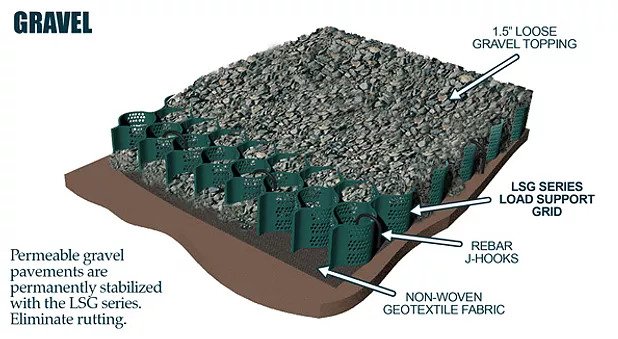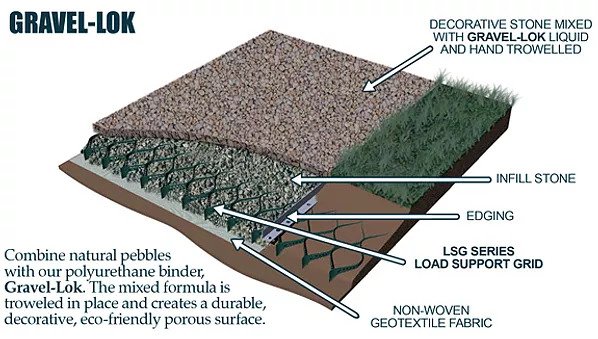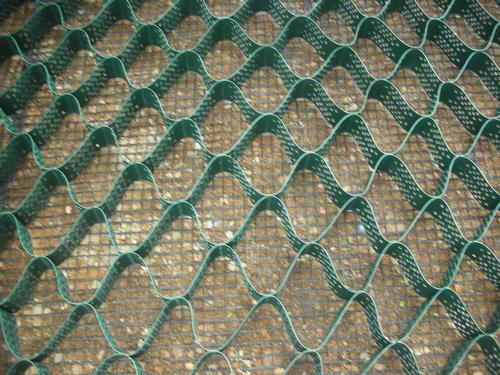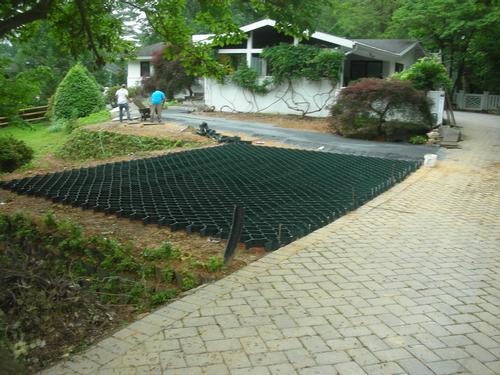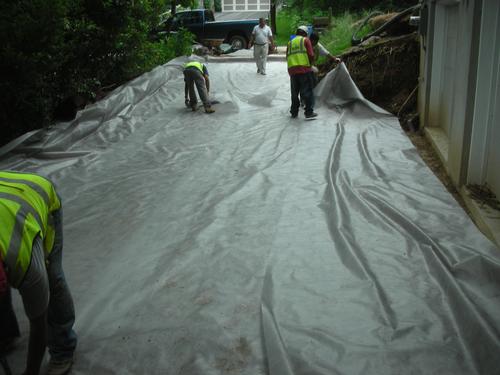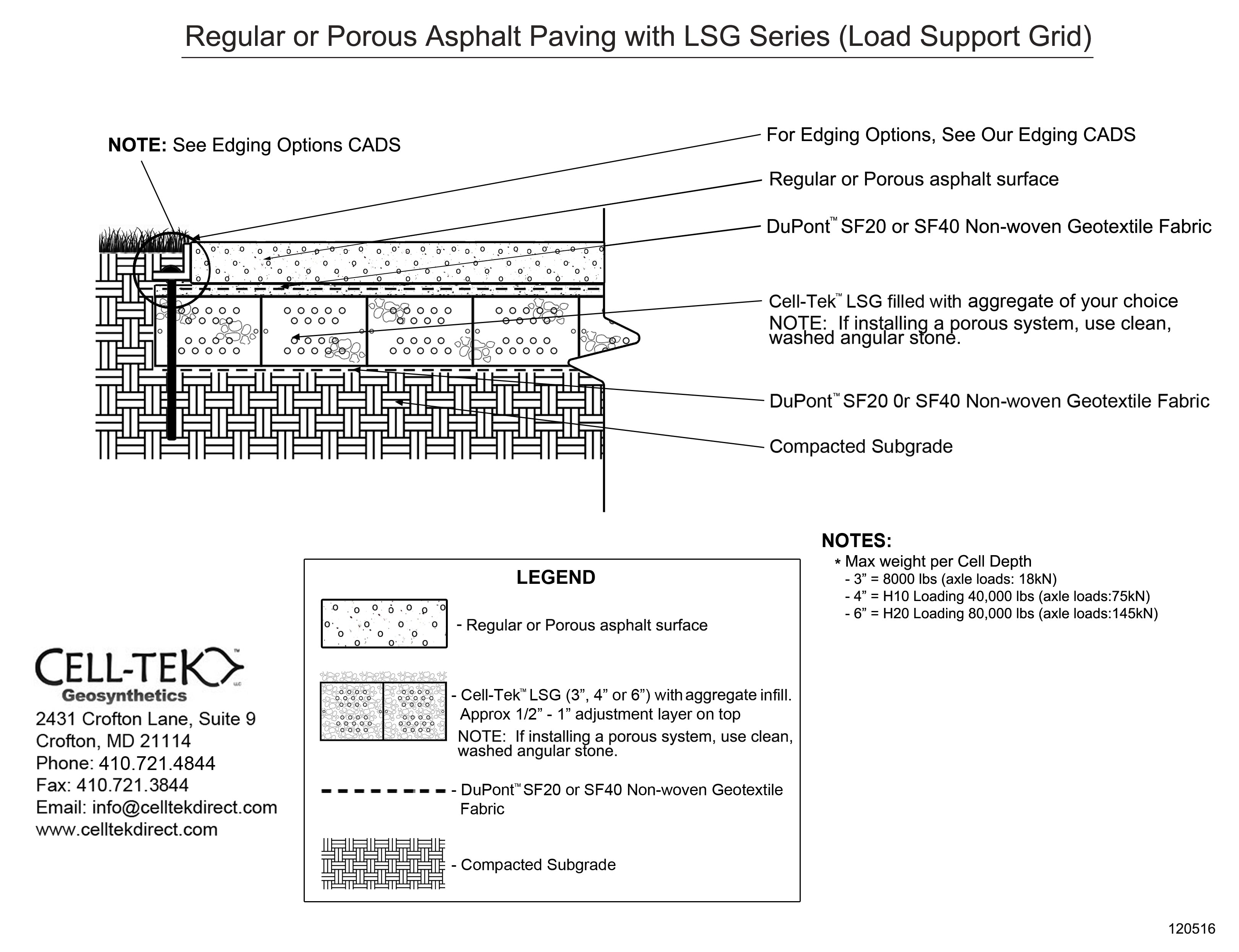
Geocells are three-dimensional synthetic materials mostly made of polymer strips placed in a honeycomb shape. The geocell forms an interlocking system in the honeycomb creating an interlocking system to secure sand, rocks, and other materials to stop erosion while offering load support. Geocells were originally designed for military roads but are now used for a large range of traffic and foot activities such as pathways, trails, landscaping architecture, green roofing, golf courses, and walkways. It's also used in construction as well as many other applications. Cell-Tek is considered an industrial leader in geocells for LSD, SlopeGrid, and other products.

The Advantages Of Using Geocells
Infrastructure development means the development and engineering of structures while guaranteeing they will not have a negative impact on natural resources. A big concern is soil stabilization and the possible risks to stability involving bridges, roads, and footpaths.
A cellular confinement system offers many advantages for engineers including increased weight-bearing capabilities, good stabilization, and affordability. Some other advantages include:
Long-lasting infrastructure.
Long-lasting infrastructure. Geocells are constantly used in civil engineering projects for constructing roads and pavements by offering a flexible base while holding soil in place. Due to their exceptional load distribution, geocells will prevent a great deal of stress cracking that often happens with paved roads as well as protection for elevated slopes. A geocell grid provides a better alternative to stone pitching or mulch mats for steep slopes. It prevents erosion without having to bring in expensive materials or skilled labor.
The cellular confinement system offers an environmentally friendly solution to create green slopes or retaining wall systems. Geocells can be filled with vegetation, concrete, or local materials such as soil or gravel without involving extensive quarrying. Using local materials will increase the positive effects on the environment by decreasing carbon footprints.

Different Types Of Geocells
Geocells have changed the entire procedure of sustainable building activities such as stabilizing building foundations and stopping soil from eroding in agricultural applications. Geocells come in different kinds and specifications to solve numerous issues involving different types of soil.
Geocells that are perforated have uniform holes in the walls of the cells to offer increased stress distribution and the reduction of deformation. Geocells that are not perforated offer smooth, solid walls.
Geonets with geomembranes and prefabricated vertical drains are often used in applications that are alternatives to geocells.

Application Using Geocells
A geocell grid will handle many issues in many industries. The following industries have come to depend on geocells.

Landscape Architecture
Landscape architecture involves protecting plants and preventing soil erosion using specialized solutions such as geocells. Geocell grids will decrease runoff or groundwater flow while stopping the formation of erosion channels that are a threat to the landscape. Other advantages include protecting riverbeds and tree roots along with stabilizing ground soil, channel walls. and preventing erosion in greenbelts, vegetation, and slopes.

Construction Of Roads
Almost 80% of roads around the world are unpaved access roads with gravel. On top of that, they were constructed on unstable soil like sand, peat bogs, and expansive clay. Without the right technology, the materials in these roads will crumble while threatening the safety, longevity, and solid components required for proper construction.
Geocells offer stiffness and creep resistance required for stability on roads with soft soil. They prevent cracking and shrinking, reduce lateral dispersion and strain from sandy soils while reinforcing subgrades in all soft soils.

Load Platforms
Geocells provide a perfect way for creating semi-rigid platforms over poor soils and areas that have digging restrictions. These geocell grids will increase the load capacity of grade slabs, strip footings, and foundation spreads. Cellular confinement systems will reduce pavement sections in laydown areas (which are areas of ground located near or at a construction site), a parking lot, or roadways.
Where there are retaining walls, embankments, and levees, erosion is always an issue when soil and vegetation require modifications. Geocells provide protection from erosion for embankments and natural slopes. Geocells also work perfectly for securing water channels and water pond linings.

Walls & Green Roofs
Green spaces including flowers on rooftops and vegetable gardens, have become extremely popular in city dwellings. Due to geocells' expandable honeycomb formation to hold soil and promote structural integrity, it's a good choice for these types of spaces. Made possible with geocell grids, green walls have become very popular for homes and offices.

Cell-Tek’s Geocell Solves Issues
Cell-Tek’s geocells can correct many problems including erosion control, stabilization of infrastructure to preserve natural resources, and the creation of sustainable eco-friendly places on buildings and in offices.

Erosion Control
Soil erosion has always been a problem, globally. Every year, natural elements such as rain, flooding, and wind will destroy nutrients in topsoil and then fill up with rivers and streams. Once erosion has hit, it's probably going to get worse over time unless action is taken to control it. That said, there are some tools for erosion control that can stop destructive cycles.
Cell-Tek Geosynthetics is the exclusive manufacturer of SlopeGrid® which is an innovative erosion control product. Erosion control is the act of preventing the loss of soil. Among some industries, including construction and agriculture, erosion can take place and cause damage by operations performed on construction sites. Soil erosion is extremely damaging to plants and wildlife unless steps are taken to prevent it from happening. The prevention of erosion plays a very important role in two engineering techniques -low-impact development (LID) and Leadership in Energy and Environmental Design (LEED).
Low-impact development is a planning technique with the goal of protecting water quality by managing stormwater runoff. Erosion can play a significant part in water pollution. Leadership in Energy and Environmental Design is better known as LEED, for the environmentally oriented building certification program run by the U.S. Green Building Council (USGBC). Created by the U.S. Green Building Council, LEED's construction goal is to support eco-conscious construction. By focusing on erosion control, construction companies can meet their goals for LEED certification. Both of these techniques show how important they are for construction companies to take into consideration erosion and how to deal with it.

The Benefits Of Erosion Control
There are important actions for erosion control that will benefit the environment.
Soil Integrity – Using anti-erosion technology, such as geotextiles, will keep sediment at bay and protect the soil from runoff caused by streams. This is not only important for preventing pollution of the water but also for protecting nutrient-rich topsoil that vegetation depends on.
Decrease Runoff Acceleration- Erosion control products are used for better topsoil in order to absorb rain. In turn, it will decrease the acceleration of runoff that might take place resulting in the loss of less sediment.
Pollution Control – There are many places where topsoil contains pollutants and chemicals left behind by agricultural activities or from construction sites. When erosion hits, pollutants are carried away along with the soil and will contaminate waterways and harm wildlife and plants. Implementing erosion control will prevent that from happening.
Supporting Biological Diversity - Biodiversity is a variety of life on Earth. It's the variation of genetics, species, and the level of the ecosystem. Biological diversity is not evenly spread out on Earth but is greater in the tropics due to the warm climate and productivity in the region. When erosion starts it will continue making areas worse off than it was before. Soil will be swept away destroying the area as well as the wildlife. When habitats are destroyed by erosion, the biological diversity in the area will plummet.

About Geotextiles
Geotextiles are a kind of synthetic material that resists biodegradation. Biodegradation is the breakdown of organic matter such as bacteria and fungi. Geotextiles are used in the ground to prevent soil layers from mixing, providing water with a filtration layer, reinforcing areas of land, and protecting the area from erosion. Geotextiles are often used along with geocells.
In areas that are known for erosion, geocells will give you the best answers on the market. With geocells' sturdy structure and high levels of reinforcement it will last for a long period of time.

Excellent Products For Erosion Control
Outside of geocells, there are many products used for erosion control such as geotextiles that come in both woven and non-woven along with blankets, wattles, and logs. These products are meant for slopes to reduce the amount of soil washed away during heavy rainfall. To choose the right product for your project, you must consider the lifespan of the product and how effective it is. In most cases, geocells will provide a long-lasting product that offers the highest level of erosion control.

Applications For Erosion Control Products
Geo erosion resources can be used in many ways depending on the application. Tools like geotextiles can serve as a filtration for controlling the level of sediment entering waterways. Other products such as logs or geocells are excellent products for soil reinforcement on sloped areas. Erosion products are extremely important for soil separation and stabilization to ensure the soil layers will remain in place despite the weather conditions.

Cell-Tek Erosion Control Products
Soil-erosion will cause a great deal of damage to wildlife, property, vegetation, and waterways. Once erosion sets in, it will continue to get worse as time moves on. Therefore, it's imperative to bring in erosion control products for the soil ahead of time. Cel-Tek provides the most effective erosion control products on the market.

Reinforcement For Steep Slopes
Stabilization for steep slopes will protect seriously inclined landscapes from soil erosion and will promote a healthy ecosystem. Stabilization can vary from one project to another depending on the environment and the overall goals. There are many stabilization products on the market designed for certain results. When planning a slope stabilization strategy, there are factors that must be taken into consideration for the landscape or what the designer has in mind.
Whatever strategy you choose, slope stabilization will help you avoid soil shifting which can easily harm structures, trees, and vegetation. In most cases, soil erosion is caused by water runoff. A reinforced slope will help protect wetlands and waterways from contamination. An excellent method of reinforcing soil slopes is geogrid slope stabilization which will allow engineers as well as construction workers to meet their specific goals and needs using different techniques.

The Benefits
Geogrid reinforced slopes can take on different forms with each being ideal for different situations. Some systems can be covered with topsoil and vegetation to create natural grass while others are filled with granular aggregate such as gravel or stones.
Cell-Tek provides soil containment, stabilization of banks, and excellent channel protection that will work even at extreme mechanical and hydraulic pressures. Their systems are ideal for:
• Protection against run-off, rill and gully formation, and erosion forces.
• Will reduce sliding and movement.
• Assist plants and roots interlocking for further stabilization of soil masses and slopes.
• Promotes infiltration and limiting the impact of hydrostatic forces.
• Reduce the amount of surface cover needed including topsoil, concrete, and gravel.
• Increase the growth of plants, the health of the soil, and overall landscape appeal.
• Increase the project's life-cycle costs or series of stages of functional activities.

Steps for Stabilizing Steep Slopes
Understand that no two slopes are alike. So you can make use of different techniques to meet the requirements of the geography, characteristics, climate, and topography. Here are some techniques for stabilizing steep slopes -
There are several techniques for stabilization. These techniques cover all the infrastructures designed to increase stability to slopes including retaining walls, pre-stressed anchors, piles, rock bolts, soil nailing, shotcrete, and geosynthetic reinforcement. Cell-Tek’s geosynthetics along with other products have defined many of the best practices within the industry for this category.
Soil stabilization techniques include mechanical actions such as interlocking cellular grids and several infill options in order to prevent the destabilization of slopes.
Protection and removal techniques. These steps and products will help in clearing unstable material that rests on the upper layer of the slope. One example is anti-erosion protective netting.
Techniques for water drainage. Water that is trapped in soil or rock mass will definitely cause an increase in water pressure which will seriously decline the slope's stability. To fight this off from happening, techniques for water drainage must limit the entry of water and control ground levels.

Stabilization Of Slopes Offered By Cel-Tek Geosynthetics
Whether caused by hydraulic or mechanical pressure or rain runoff, a slope of any significant gradation is bound to go through destabilization at some point in time. No matter the difficulty of the project, slope stabilization can be corrected using stabilization products and techniques to turn it around.

About Gravel Stabilization Grids
Gravel is the most popular material for driveways, parking lots, walkways, and other gravel surfaces. The downside, gravel surfaces require a lot more maintenance than other materials because it's loose and will gradually move, causing gaps and ruts along the surface. While the imperfections can be filled with new gravel, it will not permanently correct the problem. The best solution to reduce and stop gravel from moving is bringing in a quality gravel driveway stabilization grid.

About Gravel Stabilizer Grids
These grids are placed under the top layer of gravel. Because of their cellular nature, they are extremely effective for stopping gravel from moving around or traveling across the pavement surface while keeping the upper level of gravel stable and properly supported.

The Benefits Of Gravel Driveway Stabilizer Grids:
Originally, gravel driveways were installed by leveling the principal surface and then spreading a layer of gravel over it. That said, this form of installation has several drawbacks. It can lead to gravel erosion making it very difficult to travel over it but problems can be avoided by using a stabilization system.
Some benefits of using stabilizer grids include:
These grids will keep the gravel in place by restricting the aggregate from moving outside of the cellular structure. Stabilizer grids are created to form a more durable pavement system.
The Structural Number (SN) is used to classify the value of its performance and strength. As an example, a system that has 10 inches of unconfined gravel will have a structural number of 1.40 while confined gravel of 4 inches has a SN of 2.80.
Because the grids reduce the amount of needed gravel, the pavement system will not require top-ups over time. In turn, the amount of gravel needed for building and maintaining the paved surface will be less.
The grids will reduce rutting. Driveways that do not have a solid base will allow cars to sink into the gravel creating ruts. Outside of being an eyesore, ruts can make it very difficult to navigate over the driveway's surface.
Porous gravel surfaces are actually very good for the environment because they will allow rain to drain instead of pooling or flowing along the surface.
Grids make it easier to create a compliant surface. Stabilization grids are extremely important in forming pavement systems that are SUDS-compliant. In other words, they have a sustainable drainage system. SUDS is the abbreviation for Subjective Units of Distress Scale.
Stabilizer grids are usually invisible but offer a distinct effect. These grids are not often seen as they are covered with gravel but are known by everyone who travels over the surface they sit in. Gravel stabilizers can solve many issues associated with gravel pavement They can reduce the amount of money and time spent installing and taking care of them. The most popular uses for stabilizer grids include:
• Driveways
• Access Roads
• Paths for Golf Carts
• Playgrounds
• Bicycle Trails
• Parking Lots
• Camping Sites
• Patios
• Landscaping
• Public Parks
• Pathways
• Sports Grounds• and Many More

Cell-Tek For All Your Gravel Stabilizer Needs
As gravel material is eco-friendly, its popularity has sky-rocketed in the construction world. Even though it also has some challenges, stabilizer grids can resolve most issues. Over time, gravel driveways have become affordable and easier to manage. If you are looking for stabilizer grids, look into Cell-Tek. They offer excellent gravel stabilizers. They also offer geocell solutions that can work as a foundation for any pavement including gravel.

Access Road Stabilizers
Geocells are a kind of geosynthetic material that works like a subgrade reinforcement tool. On a broader scale, geosynthetics are made from polymeric materials to offer a cost-effective way of adding reinforcement, stability, and effectiveness to construction projects. Geocells are flat sheets of intersecting grids that have large open spaces between the ribs known as apertures.
Cell-Tek manufactures geocellular grids. Applying geocells to the subgrade at projects for road construction creates a mechanically stabilized layer to improve the bearing capacities of the road. Rutting and subgrade displacement sets off geocell's response to load support which stops unrestrained lateral movement that would take place without geocells. Cell-Tek is a leader and dependable manufacturer of geocells for road construction applications for both unpaved and access roads.

Using Geocells For Soil Stability
Geocells will strengthen and stabilize the soil by improving the bearing capacity. This is very effective for road construction on low-bearing soils. There are several benefits for using geocells for road construction operations like the reduced thickness of inbound aggregate layers which can lead to an increase in structural stabilization. In turn, this can lead to reduced cracking and maintenance costs over time.
Geocells can reduce the cost of construction because it will decrease the amount of soil excavation and backfilling. The reduced costs for these processes offer benefits for lowering the CO2 emissions involved in these projects. Geocells are environmentally friendly and will extend the life of roads.

Geocells Used In Construction
Geocells are excellent answers for all kinds of roads and are beneficial in areas with bad drainage and demanding subgrade. Geocells will increase stability and strength in all base layers and hold soil in an inflexible layer while offering better durability and load-bearing capacities. Smaller unpaved roads will benefit from geocells in areas with loose soil or demanding subgrades with stability complications.
Geocells under subgrade will last a longer period by offering greater flexibility for the life of the road while reducing the cost of maintenance due to its ability to hold soil for long-term stability. It will increase construction effectiveness by cutting back on the level of aggregate needed. Also, it offers an economical and eco-friendly answer for difficult construction conditions. Geocells are excellent for erosion control and embankment stability as well.
At one time, geocells were used mostly for retaining walls because of their flexibility, Geocells are excellent for handling projects dealing with curvatures such as the shape of the retaining wall by providing valuable resistance to earthquakes by adding stability. As of date, geocellular grids are in high demand throughout a large range of applications. They are reliable choices for many structures along with pavements and roadways.

Cell-Tek's Geocells
Geocells are economical for many construction projects. It's environmentally friendly, easy to install, and very effective even in conditions with weak soil. Geocells will increase the lifetime of small and unpaved roads with very low maintenance requirements.
Cell-Tek is a leader in offering the best geosynthetics answers for both large and small construction projects. They are known for all their products being cost-effective, and eco-friendly, while extending the life of your construction projects.
Cell-Tek offers many excellent products for your next construction project. One of their leading products is geocells for incredible stability of soil, and amazing erosion control while remaining eco-friendly and cost-efficient while providing flexibility for the life of many roads.
Frequently Asked Questions
What are geocells made of?
High-strength polymer strips welded into a honeycomb pattern that confines soil, gravel, or concrete for stability and erosion control.
Where can geocells be used?
Paths, driveways, access roads, slopes, channels, green roofs, retaining systems, load platforms, and more.
Do geocells reduce material costs?
Yes. By improving load distribution, they often allow thinner aggregate sections and less excavation.
Are geocells environmentally friendly?
They enable use of local infill, reduce trucking, support vegetation, and help manage stormwater on permeable builds.
Can I install geocells myself?
Small projects are DIY-friendly with standard site prep; large or structural projects should use a contractor or engineer.
How wide/tall are the cells?
Cell height and panel dimensions vary by application (e.g., slopes vs. driveways). We’ll recommend the right spec for your site.












